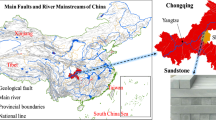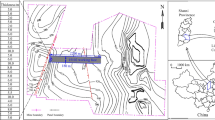Abstract
Rock environments both underground and on Earth’s surface show indications of energetic macroscale fracture. In tunnels and excavations, these manifest as rockbursts—energetic explosions of rock that can damage engineering projects, and may pose ongoing financial and safety risk as rock stresses adjust during post-failure relaxation. In natural settings at the surface, evidence for rockbursts exist in the form of tent-like structures of ruptured exfoliation sheets, but few direct observations of such events exist, precluding the analysis of how natural rock formations may evolve after rupture. Here we investigate the post-failure evolution of a granitic rock dome following rapid fracture events (i.e., surficial rockbursts) that occurred in California, USA during 2014–2016. Building upon previous work that showed a thermal stress origin for the observed fracturing, we investigate the return to background stress conditions (i.e., stress relaxation) observed in both short- (week, month) and long-term (multi-year) rock deformation trends. Acoustic emissions, deformation, and environmental monitoring data indicate that partially detached rock sheets forming the surface of the dome undergo fracture aperture closing during cooling periods, concurrent with reduction of rock stress by the source of forcing (i.e., thermal stress). However, with sufficient critical and/or subcritical fracture, our observations also show that rock sheets can become decoupled from the source of stress, resulting in a long-term return to background stress conditions. Our results provide insight into the cyclic and likely ephemeral nature of rock fracture in surficial rock domes, as well as in underground rockburst environments.








Similar content being viewed by others
References
Al Heib M (2018) Description of rockbursts in mines. In: Feng X-T (ed) Rockburst—mechanisms, monitoring, warning, and mitigation. Butterworth-Heinemann, Oxford
Atkinson BK (1984) Subcritical crack growth in geological materials. J Geophys Res 89(B6):4077–4114. https://doi.org/10.1029/JB089iB06p04077
Bahat D, Grossenbacher K, Karasaki K (1999) Mechanism of exfoliation joint formation in granitic rocks, Yosemite National Park. J Struct Geol 21:85–96. https://doi.org/10.1016/S0191-8141(98)00069-8
Bain GW (1931) Spontaneous rock expansion. J Geol 29:715–735
Blake W, Hedley DGF (2003) Rockbursts—case studies from North American hard-rock mines. Society for Mining, Metallurgy, and Exploration, Littleton
Cai M, Kaiser PK (2018) Rockburst support reference book (volume 1): rockburst phenomenon and support characteristics. Mirarco, Laurentian University, Sudbury
Carlsson A, Olsson T (1982) Rock bursting phenomena in a superficial rock mass in southern central Sweden. Rock Mech 15(2):99–110. https://doi.org/10.1007/BF01246887
Chen BR, Feng XT, Li QP, Luo R-Z, Li S (2015) Rock burst intensity classification based on the radiated energy with damage intensity at Jinping II Hydropower Station, China. Rock Mech Rock Eng 48(1):289–303. https://doi.org/10.1007/s00603-013-0524-2
Collins BD, Stock GM (2016) Rockfall triggering by cyclic thermal stressing of exfoliation fractures. Nat Geosci 9:395–401. https://doi.org/10.1038/ngeo2686
Collins BD, Stock GM, Eppes MC, Lewis S, Corbett S, Smith J (2018) Thermal influences on spontaneous rock dome exfoliation. Nat Commun 9(762):1–12. https://doi.org/10.1038/s41467-017-02728-1
Cook NGW (1963) The basic mechanics of rockbursts. J South Afr Inst Min Metall 66:56–70
Eppes MC, Keanini R (2017) Mechanical weathering and rock erosion by climate-dependent subcritical cracking. Rev Geophys 55(2):470–508. https://doi.org/10.1002/2017RG000557
Eppes MC, McFadden LD, Wegmann KW, Scuderi LA (2010) Cracks in desert pavement rocks: further insights into mechanical weathering by directional insolation. Geomorphology 123(1–2):97–108. https://doi.org/10.1016/j.geomorph.2010.07.003
Eppes MC, Magi B, Hallet B, Delmelle E, Mackenzie-Helnwein P, Warren K, Swami S (2016) Deciphering the role of solar-induced thermal stresses in rock weathering. Geol Soc Am Bull 128:1315–1338. https://doi.org/10.1130/B31422.1
Eppes MC, Hancock GS, Chen X, Arey J, Dewers T, Huettenmoser J, Kiessling S, Moser F, Tannu N, Weiserbs B, Whitten J (2018) Rates of subcritical cracking and long-term rock erosion. Geology. https://doi.org/10.1130/g45256.1
Ericson K, Olvmo M (2004) A-Tents in the central Sierra Nevada, California: a geomorphological indicator of tectonic stress. Phys Geogr 25:291–312. https://doi.org/10.2747/0272-3646.25.4.291
Feng X-T (2018) Rockburst—mechanisms, monitoring, warning, and mitigation. Butterworth-Heinemann, Oxford
Feng G-L, Feng X-T, Chen B, Xiao Y-X, Yu Y (2015) A microseismic method for dynamic warning of rockburst development processes in tunnels. Rock Mech Rock Eng 48(5):2061–2076. https://doi.org/10.1007/s00603-014-0689-3
Gilbert GK (1904) Domes and dome structures of the High Sierra. Geol Soc Am Bull 15:29–36
Goodman RE, Kieffer DS (2000) Behavior of rock in slopes. J Geot Geoenviron Eng 126:8. https://doi.org/10.1061/(asce)1090-0241(2000)126:8(675)
Grosse CU, Ohtsu M (2008) Acoustic emission testing. Springer, Berlin
Holzhausen GR (1989) Origin of sheet structure. 1. Morphology and boundary conditions. Eng Geol 27:225–278. https://doi.org/10.1016/0013-7952(89)90035-5
Jahns RH (1943) Sheet structure in granites: its origin and use as a measure of glacial erosion in New England. J Geol 51:71–98
Jones C, Keaney G, Meredith PG, Murrell SAF (1997) Acoustic emission and fluid permeability measurements on thermally cracked rocks. Phys Chem Earth 22(1–2):13–17. https://doi.org/10.1016/S0079-1946(97)00071-2
Kaiser PK, Tannant DD, McCreath DR (1996) Canadian rockburst support handbook. Geomechanics Research Centre, Laurentian University, Sudbury
Kontogianni VA, Stiros SC (2005) Induced deformation during tunnel excavation: evidence from geodetic monitoring. Eng Geol 79(1–2):115–126. https://doi.org/10.1016/j.enggeo.2004.10.012
Lawn B (1993) Fracture of brittle solids, 2nd edn. Cambridge University Press, Cambridge
Leger J-P (1991) Trends and causes of fatalities in South African mines. Saf Sci 14(3–4):169–185. https://doi.org/10.1016/0925-7535(91)90019-I
Leith K, Perras M, Siren T, Rantanen T, Wolter A, Heinonen S, Loew S (2017) Development of a new thermally-induced fracture in a 12,000 year old bedrock surface. In: Leith K, Ziegler M, Perras M, Loew S (eds) Proc progressive rock failure conf. ETH Zurich, Zurich, pp 17–19
Leveille P, Sepehri M, Apel DB (2017) Rockbursting potential of kimberlite: a case study of Diavik Diamond Mine. Rock Mech Rock Eng 50(12):3223–3231. https://doi.org/10.1007/s00603-017-1294-z
Liu GF, Feng X-T, Feng G-L, Chen B-R, Chen D-F, Duan S-Q (2016) A method for dynamic risk assessment and management of rockbursts in drill and blast tunnels. Rock Mech Rock Eng 49:3257–3279. https://doi.org/10.1007/s00603-016-0949-5
Martel SJ (2006) Effect of topographic curvature on near-surface stresses and application to sheeting joints. Geophys Res Lett 33:L01308. https://doi.org/10.1029/2005GL024710
Martel SJ (2017) Progress in understanding sheeting joints over the past two centuries. J Struct Geol 94:68–86. https://doi.org/10.1016/j.jsg.2016.11.003
Matthes FE (1930) Geologic history of the Yosemite Valley. US Geol Surv Prof Paper 160
McFadden LD, Eppes MC, Gillespie AR, Hallet B (2005) Physical weathering in arid landscapes due to diurnal variation in the direction of solar heating. Geol Soc Am Bull 117(1–2):161–173. https://doi.org/10.1130/B25508.1
Meredith PG, Atkinson BK (1985) Fracture toughness and subcritical crack growth during high-temperature tensile deformation of Westerly granite and Black gabbro. Phys Earth Planet Interiors 39:33–51. https://doi.org/10.1016/0031-9201(85)90113-X
Potvin Y (2009) Surface support in extreme ground conditions—HEA Mesh. In: Dight PM (ed) Proceedings of the first international seminar on safe and rapid development mining. Australian Centre for Geomechanics, Perth, pp 111–119
Rosser N, Lim M, Petley D, Dunning S, Allison R (2007) Patterns of precursory rockfall prior to slope failure. J Geophys Res 112:4014. https://doi.org/10.1029/2006jf000642
Senfaute G, Duperret A, Lawrence JA (2009) Micro-seismic precursory cracks prior to rock-fall on coastal chalk cliffs: a case study at Mesnil-Val, Normandie, NW France. Nat Haz Earth Sci 9:1625–1641. https://doi.org/10.5194/nhess-9-1625-2009
Stock GM, Martel SJ, Collins BD, Harp E (2012) Progressive failure of sheeted rock slopes: the 2009–2010 Rhombus Wall rock falls in Yosemite Valley, California, USA. Earth Surf Process Landf 37:546–561. https://doi.org/10.1002/esp.3192
Twidale CR (1973) On the origin of sheet jointing. Rock Mech 5:163–187
Twidale CR, Bourne JA (2009) On the origin of A-tents (pop-ups), sheet structures, and associated forms. Prog Phys Geogr 33:147–162
Warren K, Eppes M-C, Swami S, Garbini J, Putkonen J (2013) Automated field detection of rock fracturing, microclimate, and diurnal rock temperature and strain fields. Geosci Instrum Methods Data Syst Discuss 3:371–406. https://doi.org/10.5194/gi-2-275-2013
White WS (1946) Rock-bursts in the granite quarries at Barre, Vermont. US Geological Survey Circular, New York, p 13
Xiao Y-X, Feng X-T, Chen B-R, Feng G (2018) Microseismic monitoring method of the rockburst evolution process. In: Feng X-T (ed) Rockburst—mechanisms, monitoring, warning, and mitigation. Butterworth-Heinemann, Oxford, pp 301–315
Yong C, Wang C-y (1980) Thermally induced acoustic emission in Westerly granite. Geophys Res Lett 7(12):1089–1092. https://doi.org/10.1029/GL007i012p01089
Zhang C, Feng X-T, Zhou H, Qiu S, Wu W (2012) Case histories of four extremely intense rockbursts in deep tunnels. Rock Mech Rock Eng 45(3):275–288. https://doi.org/10.1007/s00603-011-0218-6
Zhao T, Guo W, Tan Y, Yin Y, Cai L, Pan J (2018) Case studies of rock bursts under complicated geological conditions during multi-seam mining at a depth of 800 m. Rock Mech Rock Eng 51(5):1539–1564. https://doi.org/10.1007/s00603-018-1411-7
Ziegler M, Loew S, Bahat D (2014) Growth of exfoliation joints and near-surface stress orientations inferred from fractographic markings observed in the upper Aar valley (Swiss Alps). Tectonophysics 626:1–20. https://doi.org/10.1016/j.tecto.2014.03.017
Zimmer V, Collins BD, Stock GM, Sitar N (2012) Rock fall dynamics and deposition: an integrated analysis of the 2009 Ahwiyah Point rockfall, Yosemite National Park, USA. Earth Surf Process Landf 37(6):680–691. https://doi.org/10.1002/esp.3206
Acknowledgements
We thank Dennis Wykoff and Lauren Gerber, Twain Harte Lake Directors for their assistance with our research efforts. We also acknowledge the contributions of our colleagues S. Lewis of Condor Earth Technologies, and S. Corbett and J. Smith (both U.S. Geological Survey; USGS) who worked with us on other parts of this project, and to R. Putnam (Moorpark College) and H. Wood (Condor Earth) who assisted with installation of instrumentation. Primary funding for this project was provided by the USGS Landslide Hazards Program. Acoustic emissions instrumentation was acquired by M. Eppes for a prior project through funding by the National Science Foundation EAR-0844335. We thank J. Perkins (USGS), R. Schulz (ARMA), and an anonymous reviewer for providing helpful feedback on earlier versions of this work. The data analyzed during the current study are available in the supplemental material accompanying this paper and/or from the corresponding author on reasonable request. Some of the work shown herein was originally presented as part of the 2018 Annual Meeting of the American Rock Mechanics Association held in Seattle, Washington in June 2018. Any use of trade, firm, or product names is for descriptive purposes only and does not imply endorsement by the US Government.
Author information
Authors and Affiliations
Corresponding author
Ethics declarations
Conflict of interest
The authors declare that they have no conflict of interest with the research presented herein.
Additional information
Publisher's Note
Springer Nature remains neutral with regard to jurisdictional claims in published maps and institutional affiliations.
Electronic supplementary material
Below is the link to the electronic supplementary material.
Rights and permissions
About this article
Cite this article
Collins, B.D., Stock, G.M. & Eppes, M.C. Relaxation Response of Critically Stressed Macroscale Surficial Rock Sheets. Rock Mech Rock Eng 52, 5013–5023 (2019). https://doi.org/10.1007/s00603-019-01832-6
Received:
Accepted:
Published:
Issue Date:
DOI: https://doi.org/10.1007/s00603-019-01832-6




